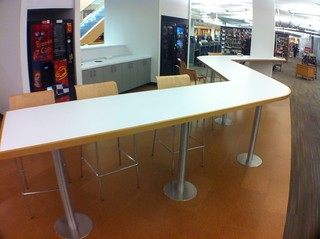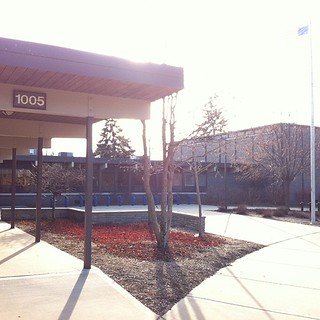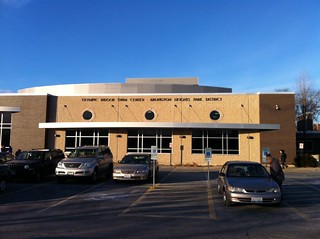

Imagine having access to multimedia studios that also serve you coffee, five community centers with indoor and outdoor swimming pools, golf courses, tennis courts and a sailing lake. No, it’s not from a new private club or development project, it’s all public and within a few miles of your home. That’s what it’s like to be an Arlington Heights resident.
While much of the village’s public space seems to be filled with commercial strip malls and retail giants, area residents count on a number of public services and amenities that would amaze most Chicagoans.
The Arlington Heights Memorial Library
We hoped to speak with a librarian that would point us to other interesting locations in the community, but never imagined the library itself would be a wonder.
The Arlington Heights library was first born at a resident’s home and the current facility was built in 1968. Since then, it’s become a key facility for local residents. The library has been remodeled twice since, but it’s now going through a major reorganization of internal space.
“We really did need to do some things that reflected the way that people are using the library today,” said Jason Kuhl, executive director of the Arlington Heights Memorial Library.
Today, this five star library is being used as a gathering spot for the community much more than in the past, Kuhl said.
The renovation includes an area called “Market Place” with newer books on display and a coffee vending machine; an expansion of conference rooms; technology classes; a lounging area with a fire place; a close faximile of an Apple store Genius Bar for helping people with their iPads or other computer devices and multimedia studios.

According to Kuhl, the library sees about 2,500 people per day. Last year, he said, the library had 900,000 visitors.
The $2.8 million project is funded from years of savings and the contributions of its local non-profit arm Friends of the Library.
Aside from monitoring expenses, the renovation didn’t require any tax increases or referendums, said Kuhl.
But while the library seems to be managing its growth and success well, the Arlington Heights Park District is finding it a bit harder to manage the demands of its own community centers.
Many parks to choose from, only two can be remodeled ….for now
With five community centers, six pools, and 715 acres of land, park district executive director Steve Scholten said, there is a lot to manage. Unlike some neighboring suburbs, Arlington Heights has parks in each of its five major neighborhoods instead of one central facility.

Two years ago, the district got a $2.5 million grant from the Illinois Department of Natural Resources to expand a facility on the far north end of the suburb- Camelot Park. The grant was contingent on local funds matching the $2.5 million award, so the parks tried to raise $48 million through a ballot initiative.
That measure was rejected by voters last March, as well as a revamped attempt for $39 million in November. Had these passed, the district could have renovated many of the facilities in the district, including three parks that all opened in 1969 (one year after the library’s current building).

This put the park district in an interesting place. Some on the board reportedly wanted to pursue using the grant money on a more centrally located park– specifically the Olympic indoor swim center. Eventually they determined the grant couldn’t be tranfered to a different project.
On Tuesday, the Arlington park district board of commissioners approved moving ahead with the expansion and renovation of the Camelot and Frontier community centers after months of debate.
“The project budget is $5.83 million and we’ll be looking for $3.33 million of funding from fund balances and non-referendum bonding sources,” Scholten said. “We are now back on track doing one building at a time and with the funding, that is the next logical step.”
So the park district had to scale back their renovation plans while the library is creating a dream facility. But why do two recreation districts in the same town have such different funding situations?
Park district officials point out the neighborhood model of the park district versus the centralized model of the library. Like the Chicago Park District, Arlington Heights positions parks throughout its residential neighborhoods instead of one or two central facilities. Due to the long and narrow shape of the town, it can be arduous to travel from one end to the other, especially at rush hour. Scholten says planners recognized this in the 1960s and defined five geographic neighborhoods that each include a larger park with a community center and outdoor pool.
The best usage figures available show around 500,000 people used all park district facilities last year (though their two tennis clubs don’t keep daily visitor records). The library, on the other hand, has only one central location and a bookmobile (but also counted 900,000 visitors last year).
Despite the maintenence complications it presents, Scholten says he wouldn’t have it any other way.
“The advantage, though, is that the neighborhoods have easy access to all the programs that we offer and all the types of facilities we offer right there in their neighborhood,” Scholten said. “So it’s a walkable, bikeable distance away for most people, and that’s very appreciated.”
He also says that they haven’t considered moving to a more centralized model because the current set-up is too popular. And it isn’t like the buildings are falling down, they’re just a little small for the amount of programs they’d like to offer.
“If we can’t renovate and expand them, we’ll just have to do the best job we can making sure we program those spaces wisely and find other community space to meet the demand,” Scholten said, dismissing the possibility of closing any current facilities.
Aside from indoor gyms, Camelot and Frontier parks may soon offer residents a place to go for walks in the winter.
“Any new gym that we build in Camelot, Frontier… they will have some sort of walking track for people to use all winter long,” said Kevin Keister the facility supervisor at Camelot Park.